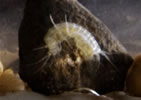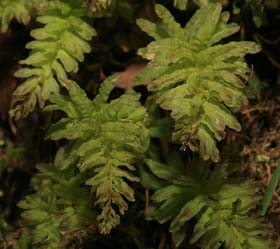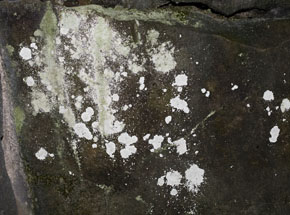As you move from outside the cave entrance into the cave threshold there is a change in the nature of plant life. This corresponds to changes in the habitats. There is a decrease in the amount of light and the increased shelter reduces wind and helps to maintain humidity (combined with the damp air in the cave). The proximity of an entrance means it will remain cool but relatively frost free. There are different methods of measuring light. Lux is one - a living room may be 60 lux, an office 400 lux and sunlight 50,000 lux.
In deep shade some plants have a different form with larger leaves e.g. Dog Violet Viola riviniana, Moschatel Adoxa sp., Harts Tongue fern Phyllitis spp., the spleenworts Asplenium spp. and Whorled Tufa-moss Eucladdium vertillatum.
FLOWERING PLANTS
Shade loving plants (sciophytes) will grow around the entrances of caves. There are three species of flowering plant commonly found in cave entrances that can cope with light levels down to 24 lux – Herb Robert Geranium robertianum (at Cuddy Gill Pot), Wood Sorrel Oxalis acetosella (at Lost Johns) and Opposite Leaved Saxifrage Chrysosplenium oppositifolium.
|
Opposite Leaved Saxifrage Chrysosplenium oppositifolium in Southerscales Nature Reserve |
Other typical flowering plants of the threshold include Ivy Hedera helix, Cuckoo Pint or Lords and Ladies Arum maculatum, Stinging nettle Urtica dioica, Dog Violet Viola riviniana and Dog’s Mercury Mercurialis perennis.
Limestone soils are generally dry, well aerated and warm and waterlogging is not a problem. The soil and organic matter around entrances can produce locally acid conditions, this allows the growth of plants not normally associated with basic limestone soils e.g. Wood Sorrel.
The rare Baneberry Actea spicata is found in the heavily shaded grykes of the limestone pavements such those in the Southerscales Nature Reserve. It has white flowers in spring and poisonous black berries in mid summer.
FERNS
Fossils of ferns date back to 400 million years ago, about 300 million years before the first flowering plants appeared. Some ferns can grow in deep shade with light intensities as low as 18 to 10 lux. Both mosses and ferns are most abundant in damp shady areas due to the need for water for the male gametes and to complete their reproductive cycle (flowering plants have evolved to overcome this problem).
In cave entrances and the grykes of limestone pavements you may see zonation of ferns as the light intensity decreases. In full sunlight you may see Wall Rue Asplenium ruta-muraria, followed by Maidenhair Spleenwort Asplenium tichomanes, Brittle Bladder fern Cystopteris fragilis and Green Spleenwort Asplenium viride.
With bright light and good drainage Wall Rue Asplenium ruta-muraria may be seen, it is also common on man made habitats such as mortar. Maidenhair Spleenwort Asplenium tichomanes (this has a dark stem) is common in cave entrances, whilst the strongly calcicole, alpine Green Spleenwort Asplenium viride (with a green stem) is found above 300m.
Hart’s Tongue Fern Asplenium scolopendrium and Hard Shield fern Polystichum aculeatum will also be found in the shaded areas along with the rare Holly fern Polystichum lonchitis, which is at its southern limit in the northern Pennines (it is frequently mistaken for young specimens of Hard Shield fern). Soft Shield fern Polystichum setiferum, which is common in Wales, Mendip and Devon, will only be found in the western side of the northern Pennines and the eastern coast.
The Brittle Bladder Fern Cystopteris fragilis prefers damp, heavily shaded conditions and is variable in shape and form. The indusia resemble minute bottles and the stipe is succulent but brittle, hence its name. (The indusium is the membrane covering the sproragia in a sorus on the underside of the fern - the brown spots!). It is a common fern around the cave entrances in the north of England.
The British Polypody species are similar and also hybridise making identification difficult. The scarcest is Southern Polypody Polypodium australe, which grows in limestone areas of south and west Britain including the western part of this caving region.
The rare Limestone Oak Fern Gymnocarpium robertianum, looking like a miniature Bracken, occurs on scree, rocks and in the shallower fissures (around 30 deep) of limestone pavements such as those in Chapel le dale. It is not found above 500m and is generally a low level species.
The Rigid Buckler Fern Dryopteris submontana is found in deeper grykes and is locally abundant on the border of Lancashire, Cumbria and Yorkshire border (i.e. around Easegill) but is very rare or absent elsewhere.
The Common Male Fern Dryopteris filix-mas prefers neutral conditions and is very common around cave entrances.
Some species prefer more acidic conditions but can still be found around cave entrances where there are moist, peaty woodland soils, acidic water or where the lime has been leached from the soil. Conditions may then be too acidic for the Shield Ferns or the Hart’s Tongue Fern Asplenium scolopendrium, but are more suited to the Lemon-scented Fern Oreopteris limbosperma, Hard Fern Blechnum spicant, Lady Fern Athyrium filix-femina, Broad Buckler Fern Dryopteris dilatata, Bracken Pteridium aquilinum and Wilson’s Filmy Fern Hymenophyllum wilsonii (a few locations in the northern Pennines). The Common Polypody Polypodium vulgare prefers acidic conditions throughout Britain, and the Western Polypody Polypodium interjectum prefers weakly acid or basic rocks and soils in western Britain. The Western and Common Polypody species are often found growing as epiphytes on tree trunks.
Many ferns are green year round but those that die back in winter (when many cavers are about), include the Brittle Bladder Fern Cystopteris fragilis, Broad Buckler fern Dryopteris dilatata, Male Fern Dryopteris filix-mas, Limestone Oak Fern Gymnocarpium robertianum, Bracken Pteridium aquilinum, Lady Fern Athyrium filix-femina and Lemon-scented Fern Oreopteris limbosperma.
There are few invertebrates associated with ferns, which is surprising given the ancient history of these two groups of organisms.
MOSSES
Mosses and liverworts are Bryophytes - simple green plants that have the ability to suspend their metabolism when desiccated (unlike a flowering plant that shrivels up and dies). Because they have no roots most of them absorb water, nutrients and gases over their whole surface. Like lichens they can be used as indicators of air and water pollution.
As you approach a cave entrance the shade increases and the ferns are replaced by mosses and liverworts - mosses are commonest at 10 lux, liverworts at 10 to 5 lux. As the light decreases only green algae and blue green algae (cyanobacteria) are found.
Anomalous Bristle-moss Orthotrichum anomalum forms neat dark-green cushions on base-rich rocks (such as limestone) and artificial walls, buttresses etc., usually in exposed situations.
Typical mosses in the more shaded parts of limestone (i.e. in the gulleys on rock faces) are the yellow-green Comb Moss Ctenidium molluscum with its curved leaves, Maidenhair Pocket-moss Fissidens adianthoides and the fan-like branches of Crisped Neckera Neckera crispa.
Extensive cushions of Common Striated Feather-moss Eurhynchium striatum can be found around the entrances, and because it is tolerant of low light small amounts are seen by the lights in show caves. Many other species of Feather-moss are found around cave entrances.
Tufa Some mosses actively promote the deposition of carbonate from seepage water to form tufa. These mosses prefer wet rock and include the pale green, dense, cushions of the Whorled Tufa-moss Eucladium verticillatum, the golden green pinnate Fern-leaved Hook-moss Cratoneuron filicinum and Curled Hook-moss Palustriella commutata. Curled Hook-moss may form extensive patches draped over dripping cliffs. There is a good example of a tufa bank at Janet’s Foss, Gordale Beck. Tufa can be dense enough to form a porous brown limestone called travertine. There are remains of travertine dams near the entrance to Ingleborough Cave.
On rocks in the splash zone of streams you often see hanging curtains of the Fox-tail Feather-moss Thamnobryum alopurum with its stiff stem. This common moss is also found above the stream in damp thresholds. It can be seen at Scoska Cave, Sleets Gill and on the waterfall by the entrance to Ibbeth Peril. It is very tolerant of low light and can be found some distance in caves.
In damp thresholds with seepage water you often find the dull green cushions of Verdigris Tufa-moss Gymnostomum aeroginosum. The cushions are a reddish colour underneath and often have liverworts growing on top.
Maidenhair Pocket Moss Fissidens adianthoides occurs on wet limestone faces.
Hart's Tongue Thyme-moss Plagiomnium undulatum is common around the entrances to Yorkshire potholes and is found all over Great Britain.
|
Hart's Tongue Thyme-moss Plagiomnium undulatum, Thistle cave, Ribblehead |
On drier shaded rock in the threshold lives the Rock Pocket-moss Fissidens dubius (= cristatus). Fissidens sp. can cope with light levels down to down to 80-90 lux and isolated patches are often seen deeper into the cave.
LIVERWORTS
Liverworts are not quite as desiccation tolerant as mosses and so prefer moister habitats. The Great Scented Liverwort Conocephalum conicum is very common in cave entrances and becomes more stunted the further into the cave it grows.
|
Great Scented Liverwort Conocephalum conicum, Bat Cave, Attermire |
Another common liverwort of cave entrances is Endive Pellia Pellia endiviifolia. This is common on dripping rock outcrops and springs.
Rock Veilwort Metzgeria conjugate has been recorded at Scoska cave and whilst it generally shuns carboniferous limestone it does grow with mosses that like mild calcareous conditions.
In limestone gulleys the Star-headed Liverwort Marchantia polymorpha may be found.
Rough Earwort Scapania aspera, is locally abundant in the Pennines on limestone rock.
ALGAE
Algae are mostly unicellular simple plants which use photosynthesis to obtain energy, producing oxygen as a by-product. Green algae use chlorophyll a and b, whilst the yellow brown algae and diatoms use chlorophyll a and c. Brown and red algae are found in the sea. A few species can cope with no light for varying lengths of time and can become a problem in show caves, especially if the lights shine on damp rock.
Green algae can be seen growing on the walls and roof inside cave entrances where it faces the entrance.
Different species of seaweed have different colour pigments to help absorb light in different depths of water. Red algae live the deepest in the sea and it is no surprise that is a red algae that you find in the depths of sea caves.
The orange patches seen on limestone is actually a green algae called Trentepohlia. It contains red carotenoid pigments that may protect the algae from high light intensities, these pigments mask the green chlorophyll. The genus Trentepohlia is the second most common algal component of lichens.
If there is enough light algae are dominant over the cyanobacter, but as the light diminishes into the cave so the cyanobacter become dominant.
|
Cyanobacter (blue-green algae) and green algae in the threshold of Lower Long Churn Cave |
The common green, powdery algae is a species of Pleurococcus which can obtain moisture from the air and so can live on dry walls.
Other colours are more likely to be cyanobacter (= blue-green algae).
LICHEN
Lichens are usually mutualistic associations between fungi (often ascomycetes) and photosynthetic partners, usually algae but sometimes cyanobacter (blue-green algae).
Those with cyanobacter require wet conditions to survive, most of the these can also fix nitrogen. The fungus forms the bulk of the lichen including the exterior, and protects the photosynthetic partner. The definition of a lichen is constantly changing as scientists discover new associations. There are many species of fungi that form lichens, but comparatively few photobionts. Lichens have colonised a wide range of habitats from sea level to mountain top, hot deserts to antartica and artic tundra.
Many 'species' live on limestone, and their hypae may actually extend into it. Those on limestone are often small and difficult to identify - as a result they have been neglected by biologists and there is scope for new discoveries in this area. Different species of lichen show a preference for different substrates, so those on limestone will differ from those on trees which mostly have an acidic bark.
Lichens found on carboniferous limestone do not appear to vary much across the regions of Britain. Typical lichens of damp, shaded limestone are Gyalecta jenensis (circular, grey/pink/orange), Acrocordia conoidea (grey/pink, circular black spots), Agonimia tristicula, Catillaria lenticularis, Collema mulipartitum and Porina linearis.
On steep dryish limestone walls around cave entrances e.g. Dow Cave and Great Douk, you can see a whitish crusty looking lichen - this is a species of Lepraria.
At Scoska Cave the species of lichen changes as you move into the cave: the white/grey Lepraria nivalis at the entrance where it is protected from rain, the powdery mustard/orange Caloplaca chrysodeta (=Leproplaca chrysodeta) prefers drier sheltered crevices found up to 6m in, and the grey/green Lepraria incarna up to 17m into the threshold. The latter prefers shaded siliceous rocks, a similar species found on shaded calcareous rocks is Lepraria lobificans.
|
Lepraria, Long Churn Cave |
A brown jelly like cyanobacterium (=blue-green algae) seen outside cave entrances is Nostoc sp. This occurs as both a free living cyanobacter and in association with a fungus to form a lichen Collemma sp. When wet this lichen swells up and becomes jelly like, hence its name, jelly lichen. Nostoc is a photobiont that cannot survive on acidic rocks like granite and quartzite.
|


.jpg)

.jpg)
.jpg)
